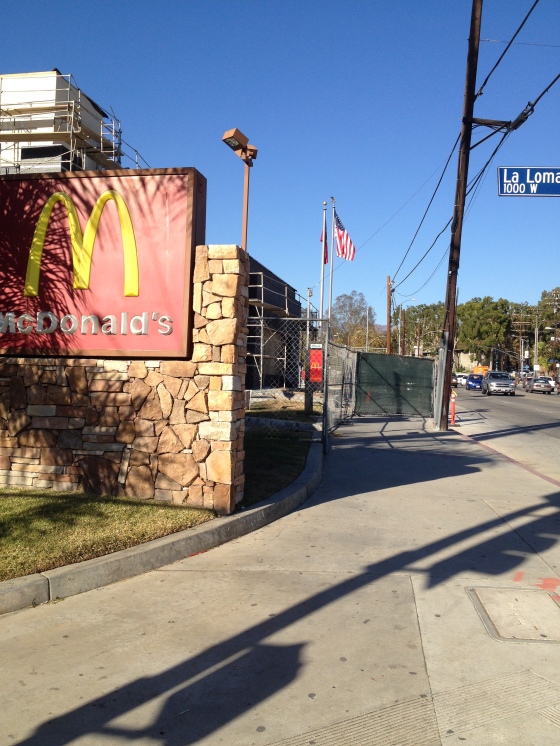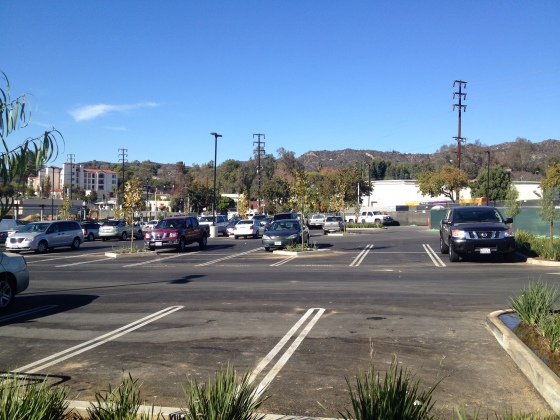There’s a Vons grocery store a few blocks away from my office, and when I need to get something quick for lunch, I’ll walk down and grab a sandwich. Walking down there is no small feat in itself, as the neighborhood is particularly hostile to pedestrian traffic. There are sidewalks, but they’re fairly narrow, and are fronted by parking lots, a gas station, a middle school that looks like a prison, a car wash, and a McDonald’s, which, having grown too obese from it’s own product, has inexplicably devoured the sidewalk:
But I’ll save the journey to the Vons for a different post.
The Vons itself is also under construction, and there’s a new building going up on the corner, which is good. Previously it was a vacant lot, and now there will be a building on the corner to anchor things. But another building means (according to LA City codes) the need for more parking…even though the parking lot at the Vons is already over-sized and never at capacity.
It might be a little hard to see in the picture, but it should be noted that there are multiple signs (appropriately sized to be easily read from cars moving at 40mph) indicating to the public that the Vons is, in fact, open during construction. It’s so poorly placed in relation to the street that a casual passerby would never even be able to tell that the store was open; it just looks like a construction site. If the store fronted the street instead of having a huge parking lot in front, even covered in scaffolding, there’d be no question of whether or not it was actually open. Not only would you see people coming and going from the entrance (or through the front windows), but you wouldn’t see a parking lot with less than 1/3 of the spaces occupied. No wonder they need a sign to tell us they’re open!

Yes, we’re open (though you couldn’t tell from the street)! Apologies for the crooked pic, but there’s no ped walkway, and I was trying to take this with cars speeding in and out of the driveway. This Vons gets better and better!
Which brings me to my new discovery, and the point of this whole post: There is such a thing as “carpool parking.” Now, having never encountered this before, I can only assume that these are spots reserved for people who come to the store together. Just like a carpool lane on the freeway requires 2 or more passengers per vehicle, my best guess is that these spots are reserved for cars containing 2 or more occupants.
Let’s consider the absurdity of this.
First and foremost, what is the actual goal here? Clearly it’s not reducing the number of cars here, because they’re expanding an already-too-big parking lot to accommodate more cars. The parking lot has been doubled in size to accommodate a single story building that’s 2000-3000 square feet, at the most, and despite a remodel, the Vons didn’t get any bigger. And if the goal is to reduce the number of cars, how does designating 3 spots for “carpools” every few rows accomplish this? If we define carpools as simply 2 or more people in a car, that has barely any affect on the total number of car trips. Consider all the car trips to the store that will occur with more than one person in the car: parents with children, spouses, partners, roommates, co-workers, friends. And these trips will happen, regardless of whether or not we’re encouraging people to carpool to the store. Congratulations, Vons! Over the course of the year, there’s probably going to be a net reduction in car trips to the store of about 12, and that’s being generous.
Secondly, they’ve offered no incentive for people to park in these spots. None. The advantage of a carpool lane on the freeway is that, in theory, it keeps moving even when the rest of the freeway is backed up. Regardless of how you feel about carpool lanes, there is a clear advantage for vehicles with more than one occupant where they exist. But Vons had the incredible idea of making the “carpool parking” the furthest spots from the store entrance! Now I don’t know about you, but I would try to park as close to the store as I could, even if I was driving a bus filled with 30 people.
Finally, the question remains, how do they intend to enforce this? There’s no security guard or parking lot attendant, and I hardly think the Vons’ employees are going to care enough to even bother. And really, with how much space there is and the huge inconvenience of the “carpool” spots themselves, it’ll probably never come up. So why put them there in the first place?!?

This Prius arrived while I was standing here. There was only 1 person in the car. I think that in itself proves my point.
A call to the Los Angeles Department of City Planning to find out more about “carpool parking” got me 15 minutes on hold, and 12 seconds with an operator who supposedly transferred me…to another hold. They do have some helpful pre-recorded tips about paying permit fees that do not require a plan inspection, but it was otherwise fruitless. Look for a followup post on actual carpool parking requirements once I can actually get ahold of someone.
Overall, the idea of a carpool parking spot is incredibly asinine. My best guess is that a directive was handed to the city planning department that all new development needed to be “greener,” and this is what they came up with. When your perception of the world has been shaped by car culture, and where literally everything you need to do requires a car, the best you can come up with in this scenario is reducing the number of car trips by increasing the number of people in the car. The problem with all current progressive initiatives, be they environmental, architectural, or consumer, is that they accept the status quo as a necessary evil to be tempered, not as something that can be changed. We don’t really need cars, we’ve just made them necessary.
As we’ve seen, these parking spots serve no purpose, and aren’t even addressing any real problems. Referring to a parking spot on the fringes of a sea of open parking as “carpool” is about as effective as declaring that the sky is green: just because you believe it, doesn’t make it so, nor does it change the reality. The real problem is the effect this sort of development has on the whole neighborhood, and if we addressed that, we would inadvertently make things more “green” and “sustainable”. Why can’t we have a grocery store that doesn’t require us to drive to it at all? What a novel concept. We could easily walk to the store, bettering our health, reducing our carbon footprint, and interacting with the people in the neighborhood.
And to leave things on high note, here’s the sprawling parking lot in all her glory:
God Bless America!







